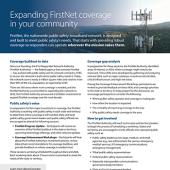This blog is a repost from MissionCritical Communications magazine, originally published in the Summer/Fall 2022 edition.
A few years ago, remote 9-1-1 seemed like a remote possibility — an interesting concept but challenging to implement with the technology and resources available. Then the pandemic hit, and the public-safety community had to re-think how it approached in-person work.
Emergency communications center (ECC) directors grappled with the question of how to maintain operations when their staff needed to quarantine or socially distance. They needed a way to untether 9-1-1 operations from fixed work-stations so telecommunicators could take, process, dispatch, and supervise calls from any location. Suddenly, remote 9-1-1 capabilities needed to move from nicety to necessity.
Like many others at the start of the pandemic, 9-1-1 leaders looked to technology for a solution. Through FirstNet, the nationwide public-safety broadband network, first responders had access to a secure, reliable connection outside of the ECC. Forward-thinking leaders took it upon themselves to find ways to use broadband access to support remote 9-1-1 operations.
Through significant testing, they discovered that using IP remote consoles and a virtual private network (VPN) connection, staff can take calls and dispatch from anywhere there is internet connectivity, even outside the radio frequency coverage footprint of the agency. With a strong broadband connection, telecommunicators can set up ad-hoc dispatch stations with relatively limited, lightweight equipment. This has translated into several remote 9-1-1 solutions, from “go bags” to home-based dispatch stations.
Grab and Go: 9-1-1 in a Bag
When the COVID-19 pandemic struck, Palm Beach County (Florida) 9-1-1 call centers were faced with a new set of challenges. If a call-taker was exposed to the virus or needed to take care of an ill family member, they were required to quarantine for 14 days. With a suddenly depleted staff, the call center’s managers were looking for solutions to enable remote work.
With FirstNet already in place as a backup at the public-safety answering points (PSAPs), former Palm Beach County 9-1-1 Director Chuck Spalding and his team created go-bags, complete with 9-1-1 call handling equipment, a headset, and a FirstNet modem. This allowed call center managers to enable remote call-taking and dispatching from home or from other physical facilities, allowing for social distancing.
“FirstNet is what gave us the confidence we needed to provide a remote-work option to our operators,” Spalding said. “We average about 100,000 9-1-1 calls per month, and this gives them the ability to do their job without being physically tied to a specific building, ensuring that every one of those calls continues to be handled in an appropriate manner. This is beyond what we originally began using FirstNet for, and we certainly never thought 9-1-1 call centers could ever utilize a remote workforce.”
In Alexandria, Virginia, hotspots, and smartphones powered by FirstNet enable 9-1-1 telecommunicators and dispatchers to take calls and handle CAD operations from their homes and other remote locations. The dispatchers have the full functionality of the center at their fingertips.
All of the equipment fits into a large laptop bag and is easy for personnel to assemble and disassemble themselves. Their kits include a laptop, two monitors, headset, smartphone, FirstNet hotspot, mobile router with CAD, and other necessary hardware. The dispatchers at home access the department’s CAD system remotely by connecting to laptops at their normal dispatching positions back at the 9-1-1 center.
“Why we decided to go with FirstNet and go remote was, first, to make sure that our staff was safe,” explained Renee Gordon, director of the city of Alexandria’s Department of Emergency and Customer Communications (DECC). “The second thing was to maintain continuity of our operations—to make sure that we’re still able to support police, fire, and emergency services.”
Alexandria’s DECC is in the process of expanding the remote call-taking and dispatching capabilities moving forward.
Testing the Technology
With any new technology solution, testing is critical. But when it comes to public safety technology, testing is paramount to ensuring the safety of responders and citizens alike.
Before launching remote dispatch, the city of Alexandria’s DECC implemented planning and testing in three phases. For the first month, the remote workers answered only non-emergency phone calls. This continued until 9-1-1 leaders decided the system was working and allowed 9-1-1 calls to be handled as well. Once the system was fully vetted, the DECC was able to set up dispatch teams at the primary ECC, the backup ECC, at home, and at a nearby hotel where teams could isolate.
Arlington County in Virginia also rolled out remote work in phases. They started with call-taking, working with other regional ECCs like DECC to share best practices. They expanded to remote dispatch and supervision when they had to set up a call supervisor at a remote center so that she could work and social distance.
“If you could supervise in the backup center, why couldn’t you supervise certain parts of the operation from 30 miles down the road or wherever?” said former Arlington ECC Director Dave Mulholland, now director of the Department of Public Safety Communications for Fairfax County Government.
With that idea in mind, the ECC came up with a technical plan, ran test sessions with fail-safes in place, and tweaked operations and equipment based on real-life use and feedback from telecommunicators. When remote dispatch and supervision went live, remote workers had counterparts sitting in the ECC to step in if there was a problem with a dropped connection. Today, they can provide remote on-the-job training with the communications training officer working remotely while the trainee is in the center.
Six counties from across Maryland staged a 9-1-1 expo with live call-taking from a remote and crowded location using FirstNet. A statewide initiative from the early days of COVID-19 sought to establish the tools and capabilities for remote 9-1-1 operations. The expo was conducted at the Maryland Association of Counties winter conference. 9-1-1 specialists from across the state set up call equipment in a large conference room. Of the six counties participating, three agencies were taking live calls from their home counties. The other three agencies were remotely monitoring calls happening at their counties’ ECCs. With 1,500 attendees at the conference, the biggest challenge reported by the telecommunicators was background noise from the crowds. The technology worked as if they were sitting in their home centers.
“We were able to successfully demonstrate that you can take 9-1-1 calls from anywhere,” said Ross Coates, communications manager for the Harford County 9-1-1 Center. “Today, using FirstNet as our internet service provider or backhaul to connect back to our equipment in our local 9-1-1 centers, we processed many 9-1-1 calls.”
Mutual Aid and TERT Response
Remote capabilities make it easier to offer mutual aid to neighboring agencies. “We’ve had to identify ways to become more resilient, but also consider that we could have a 9-1-1 center not taken down by an attack or a disruption in communication, but a sheer lack of staffing,” said Scott Boggs, director of homeland security and public safety for the Metropolitan Council of Governments. “And that has brought opportunities for Alexandria and Arlington that will provide not just resilience for them, but the ability to potentially stand up a capability to handle calls for service from other jurisdictions.”
Broadband access also presents the opportunity for virtual Telecommunicator Emergency Response Taskforce (TERT) response. The Collier County (Florida) Sheriff’s Office planned an exercise to transfer non-emergency calls from a fair in Naples to dispatchers located at the Charleston County Consolidated 9-1-1 Center in South Carolina. The calls would be transferred from Collier County to Charleston over a 9-1-1 call handling system. The remote dispatchers would process the call, enter it into cloud-based CAD, and then use an enhanced push-to-talk (ePTT) service to dispatch responders at the fairgrounds, who would access the systems via a FirstNet connection provided by a deployable network device. All of this would occur from dispatch workstations in Charleston.
Similarly, the Hamilton County Communications Center in Ohio uses FirstNet for tactical dispatch because it allows it to remain operational at all times, despite its location, with access to the same tools and information dispatchers have in the dispatch center. Dispatchers no longer must resort to tracking calls with pen, paper, or spreadsheets when they are in the field. Over broadband, they can jump right into accessing their normal CAD system.
During a large storm, Hamilton County received nearly a thousand calls in a four-hour period. Andrew Knapp, director of the Hamilton County Communications Center, was able to use his remote 9-1-1 setup over a FirstNet hotspot on his phone. Thanks to a battery backup, he could operate for hours even if he had lost power.
A Key Tool for ECCs
Across the nation, 9-1-1 officials are beginning to embrace remote 9-1-1. A 2020 survey of 9-1-1 PSAPs found that only 7% of responding agencies had the ability to conduct PSAP operations from staff member’s homes. In the last two years, public-safety agencies have tested and adopted the technology to make that happen securely and reliably.
Remote 9-1-1 operations are becoming critical elements of preparedness efforts. They enhance the continuity of operations plans by avoiding having a single point of failure in the system. Instead, staff can quickly set up where they are, ready to support operations. During an unexpected period of high calls in the area, Arlington dispatchers found that they were able to immediately activate additional telecommunicators at their homes, rather than wait for them to travel up to two hours into the city.
Beyond offering pandemic safety measures, ECC leaders see the value of having remote dispatch and call-taking capabilities during natural disasters, severe weather emergencies, and planned events. Telecommunicators now have an alternative way to operate if they cannot physically get to their ECC, the center is damaged, or they need a fail-safe.
Thanks to public-safety agencies across the country taking on the challenge to test and adopt this technology, remote 9-1-1 is no longer an idea for the future but an available tool that can be implemented today. With these capabilities, agencies can expect mobility and flexibility to be core characteristics of their emergency communications centers.




















